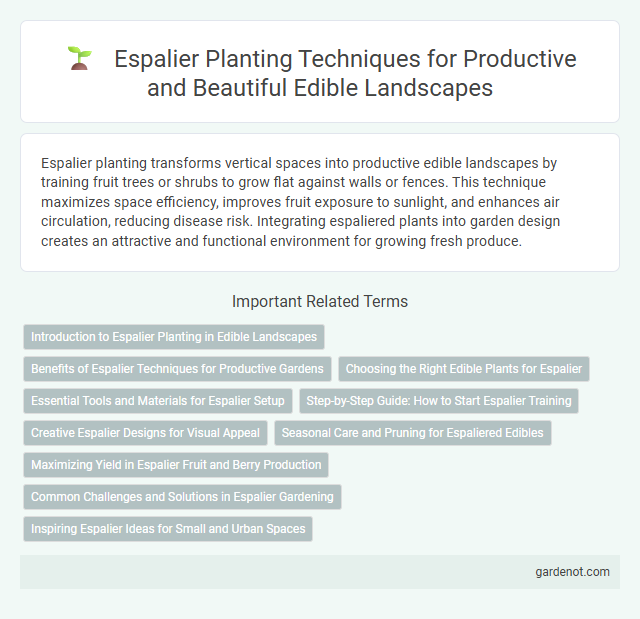Espalier planting transforms vertical spaces into productive edible landscapes by training fruit trees or shrubs to grow flat against walls or fences. This technique maximizes space efficiency, improves fruit exposure to sunlight, and enhances air circulation, reducing disease risk. Integrating espaliered plants into garden design creates an attractive and functional environment for growing fresh produce.
Introduction to Espalier Planting in Edible Landscapes
Espalier planting is a tree training technique that maximizes limited garden space by growing fruit trees flat against walls or fences, creating both functional and decorative edible landscapes. This method enhances sunlight exposure and air circulation, improving fruit quality and yield while allowing easy harvesting. Commonly used with apple, pear, and fig trees, espalier supports diverse food production in urban and small-scale garden settings.
Benefits of Espalier Techniques for Productive Gardens
Espalier planting maximizes limited garden space by training fruit trees or shrubs against walls or fences, enhancing sunlight exposure and air circulation for healthier growth. This technique increases fruit yield per square foot and simplifies harvesting and maintenance by keeping plants accessible and well-organized. Espalier also improves garden aesthetics, creating living walls that combine productivity with decorative appeal.
Choosing the Right Edible Plants for Espalier
Selecting the right edible plants for espalier involves prioritizing fruit trees and vines such as apples, pears, figs, and grapes that naturally adapt to training along flat structures. Consider disease-resistant varieties that thrive in your local climate and soil conditions to ensure healthy growth and higher yields. Compact growth habits and flexible branches are essential traits for effective espalier shaping and maintenance.
Essential Tools and Materials for Espalier Setup
Essential tools for espalier planting include sharp pruning shears, sturdy garden ties, and a reliable trellis system to guide branch growth. Durable materials such as galvanized wire, wooden stakes, and flexible twine are necessary to support and shape the plant efficiently. Maintaining proper tension with adjustable fasteners ensures healthy growth and a visually appealing edible landscape.
Step-by-Step Guide: How to Start Espalier Training
Start espalier training by selecting a young, flexible tree such as apple or pear and planting it near a sturdy support structure like a trellis or wall. Prune the central leader and choose two or more strong lateral branches to form the basic framework, tying them horizontally to guide growth. Consistent seasonal pruning and tying new shoots will maintain the shape and encourage fruit production along the trained branches.
Creative Espalier Designs for Visual Appeal
Creative espalier designs transform edible landscapes by shaping fruit trees into striking visual elements that maximize space efficiency and yield. Techniques such as fan, candelabra, and cordon training not only enhance aesthetic appeal but also improve air circulation and sunlight exposure, promoting healthier growth and fruit production. Incorporating espalier patterns along fences or walls creates vibrant living art that blends functionality with garden beauty.
Seasonal Care and Pruning for Espaliered Edibles
Seasonal care for espaliered edibles involves regular monitoring of soil moisture and nutrient levels to promote healthy growth and fruit production. Pruning is essential during the dormant season to remove dead or overcrowded branches, shaping the plant for optimal light exposure and air circulation. Timely pruning in late winter encourages vigorous spring growth and maximizes fruit yield while maintaining the desired espalier form.
Maximizing Yield in Espalier Fruit and Berry Production
Espalier planting techniques significantly maximize yield by training fruit and berry plants against flat surfaces, optimizing sunlight exposure and air circulation. This method enhances photosynthesis efficiency, leading to higher fruit production per square foot compared to traditional planting. Precise pruning and strategic branch placement in espalier systems ensure vigorous growth and easy harvesting, boosting both quantity and quality of edible landscape crops.
Common Challenges and Solutions in Espalier Gardening
Espalier gardening faces common challenges such as managing limited sunlight, controlling pests, and ensuring proper pruning techniques to maintain desired shapes. Addressing these issues involves selecting disease-resistant plant varieties, using organic pest control methods, and applying regular, precise pruning to promote healthy growth and fruit production. Adequate spacing and soil nutrition also enhance the success of espaliered edible plants in landscape settings.
Inspiring Espalier Ideas for Small and Urban Spaces
Espalier planting transforms small and urban spaces into productive edible landscapes by training fruit trees and vines flat against walls or fences, maximizing limited space and sunlight exposure. Techniques such as horizontal cordons and fan shapes efficiently utilize vertical surfaces, making them ideal for growing apples, pears, figs, and grapes in compact areas. Incorporating espalier plants not only enhances urban aesthetics but also increases homegrown fruit production in constrained environments.
Espalier planting Infographic

 gardenot.com
gardenot.com